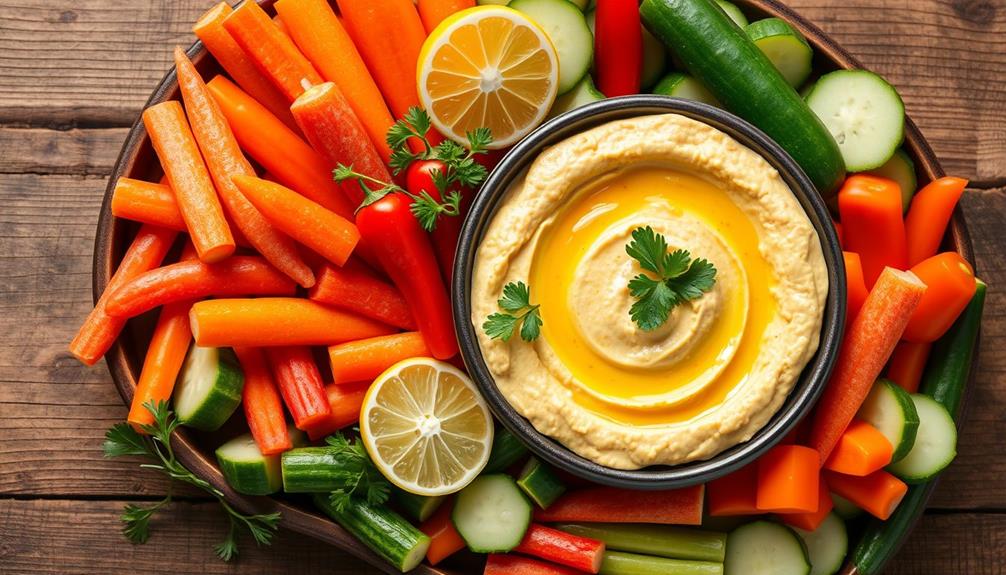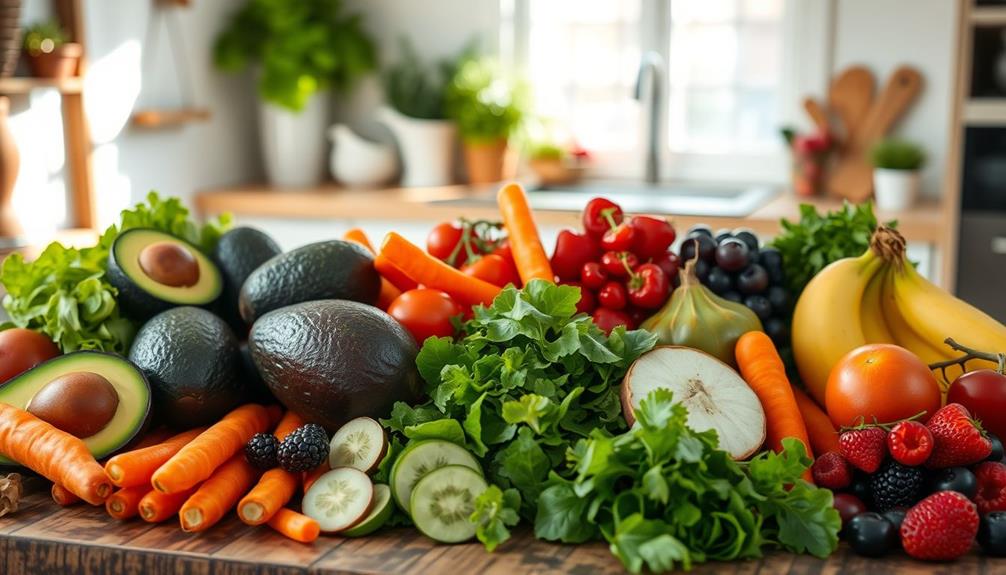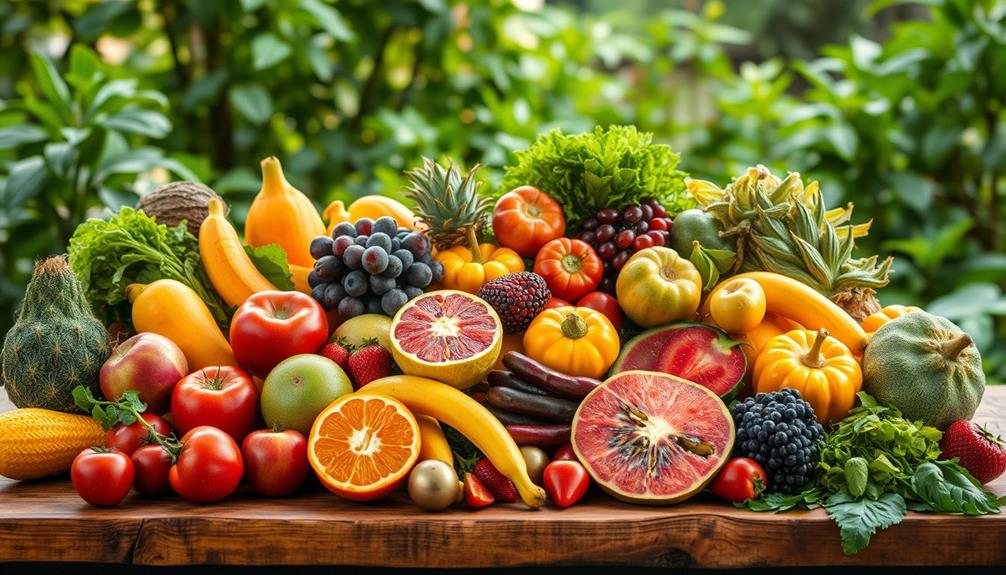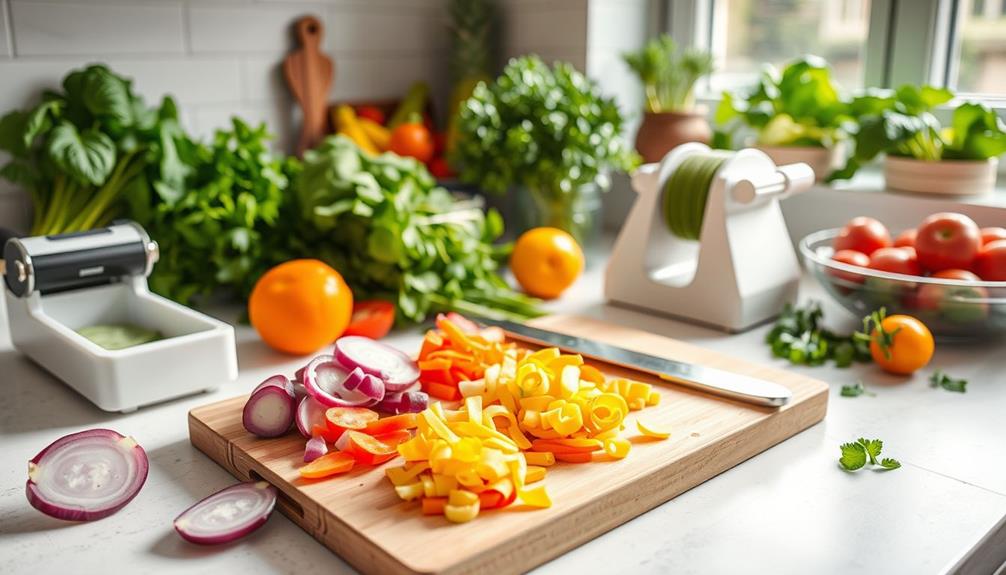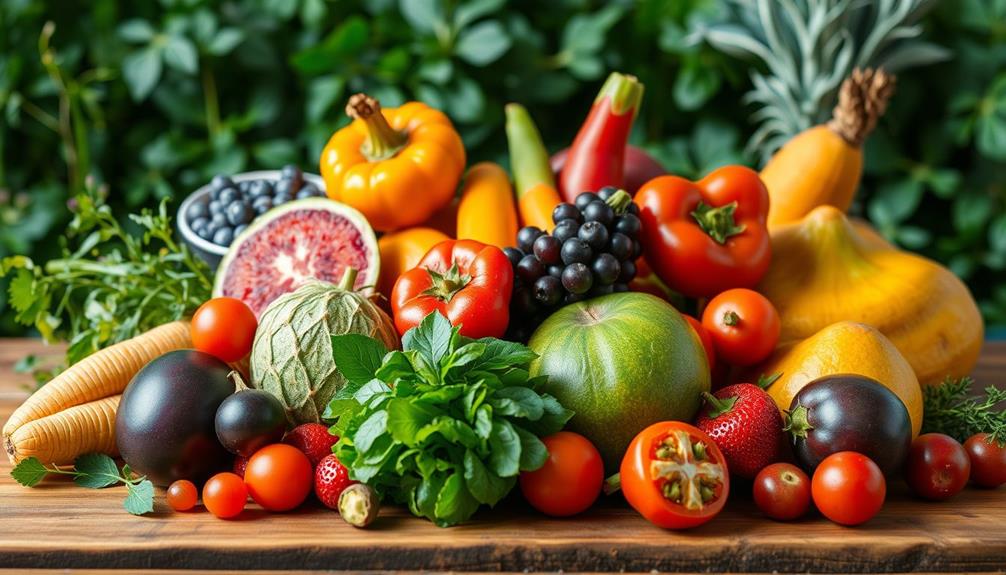Hummus isn't classified as a raw food because traditional recipes use cooked chickpeas. While classic hummus is rich in plant-based protein and healthy fats, it doesn't meet raw food standards. However, you can enjoy raw hummus varieties that use sprouted chickpeas or zucchini instead of cooked beans, preserving living enzymes and nutrients. These raw options maintain a creamy texture and can be even more nutritious. If you're curious about how to make your own raw hummus or what ingredients to include, stay tuned for more tips and delicious recipes.
Key Takeaways
- Traditional hummus is made from cooked garbanzo beans, disqualifying it from being classified as a raw food.
- Raw hummus uses sprouted beans or zucchini, maintaining a raw status and retaining living enzymes.
- Ingredient quality is crucial; look for sprouted beans, raw tahini, and fresh vegetables in raw hummus.
- Cooking destroys living enzymes and reduces the nutritional benefits sought by raw food enthusiasts.
- High Pressure Processing (HPP) can maintain freshness in raw hummus without cooking, but ingredient checks are essential.
Understanding Veganism
Veganism isn't just a diet; it's a lifestyle choice that aims to eliminate all forms of animal exploitation. You commit to avoiding animal products, including meat, eggs, dairy, and honey, promoting cruelty-free choices that extend beyond your plate.
The Vegan Society emphasizes that this lifestyle advocates for ethical treatment and minimal exploitation of animals, a philosophy that's gaining traction as more people seek healthier and sustainable living options.
In adopting veganism, you'll discover a rich variety of foods that nourish your body. Your diet will likely be filled with fruits, vegetables, whole grains, nuts, and seeds, all offering numerous health benefits and lower risks of chronic diseases.
Plus, with the growing market for vegan products, you won't have to sacrifice taste or convenience.
If you're looking for a delicious and nutritious treat, try a raw vegan hummus recipe. Using a food processor, you can whip up a creamy blend of soaked chickpeas, tahini, lemon juice, and garlic, creating a satisfying dip that aligns perfectly with your vegan lifestyle.
Embracing veganism opens up a world of flavors while staying committed to ethical eating.
Exploring Raw Foodism
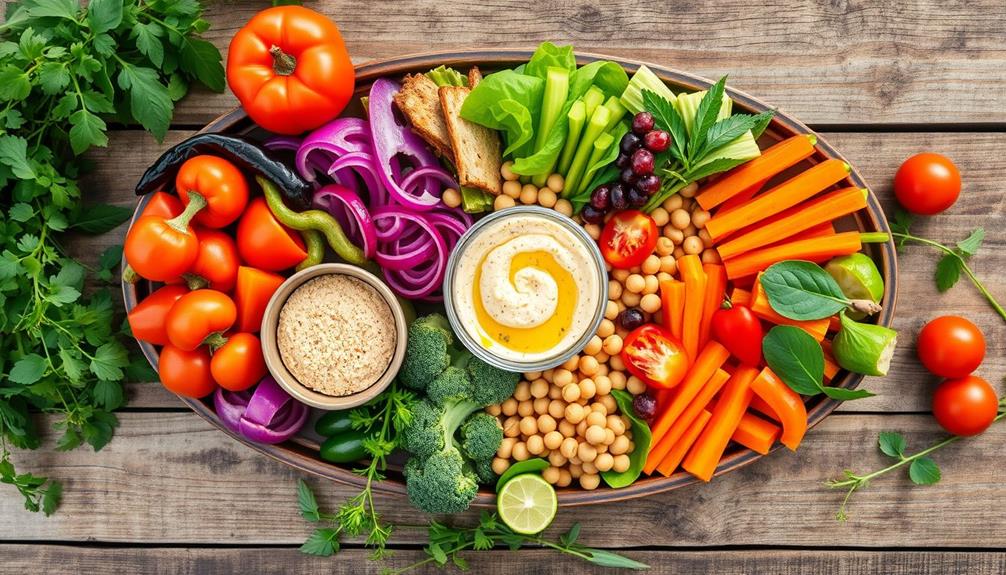
Raw foodism is all about embracing a diet made up of uncooked, unprocessed foods, keeping temperatures below 115°F to preserve essential nutrients.
This approach often includes nutrient-rich ingredients like celery juice and beetroot, which are known for their health benefits and can enhance overall well-being.
You'll find that this lifestyle not only includes a variety of organic fruits and vegetables but also emphasizes the nutritional benefits of fermented foods.
As you explore common raw ingredients, you'll discover how they can boost energy and improve digestion, while also being mindful of potential digestive issues associated with certain raw foods like beets nutrition benefits of raw foods.
Raw Food Definition
Embracing a raw food diet means consuming uncooked foods that typically don't exceed 115°F, which helps preserve living enzymes and maximize nutritional benefits. This lifestyle focuses on organic vegetables, fruits, nuts, seeds, and superfoods, prioritizing plant-based ingredients. Advocates believe that cooking can diminish the nutritional value of foods and destroy essential enzymes necessary for digestion.
Incorporating raw foods can also complement other health practices, such as using essential oils for wellness, including essential oils for respiratory health, which can enhance your overall energy.
When you adopt a raw food diet, you might experience:
- Increased energy levels
- Enhanced digestion and gut health
- A vibrant, glowing complexion
- A deeper connection with nature
- A sense of community with like-minded individuals
Fermented foods and drinks often find their way into this diet as well, providing gut-friendly probiotics that support overall well-being.
By choosing raw options, such as raw hummus, you're not just satisfying your taste buds; you're also nourishing your body with nutrient-dense foods. Many followers of raw foodism report feeling better and more vibrant, making this diet an appealing choice for those looking to improve their health and well-being.
Nutritional Benefits Explored
Understanding the nutritional benefits of raw food can transform your approach to meals, especially when it comes to options like hummus. While traditional hummus made from cooked chickpeas lacks the raw classification, you can explore raw alternatives that use sprouted beans or fresh vegetables, which can enhance nutrient absorption and digestive health.
Incorporating cold medications that support overall wellness can also complement your dietary choices. These options preserve essential living enzymes, vital for ideal nutrient absorption and digestive health.
Incorporating raw ingredients into your hummus not only enhances its flavor but also boosts nutrient density. Fresh vegetables, nuts, and seeds provide a wealth of vitamins, minerals, healthy fats, and protein. This combination supports overall health and well-being.
If you're managing your weight, raw hummus fits perfectly into a raw vegan diet. It offers high-volume, low-calorie options that promote satiety without leading to excessive calorie intake.
When you blend fresh ingredients for raw hummus, you're not just improving the texture; you're also maximizing the health benefits associated with a raw food diet. By embracing these nutritional benefits, you're making a conscious choice to nourish your body with wholesome, uncooked foods.
Common Raw Ingredients
Incorporating a variety of common raw ingredients can elevate your hummus and align it with raw food principles. By using fresh, nutrient-dense components, you not only enhance flavor but also maintain the essential enzymes that cooking often destroys.
Start with organic garbanzo beans, which can be soaked and sprouted for added health benefits. Exploring different textures and flavors can also enhance your experience in the kitchen, much like understanding the mechanics of various brewing methods in coffee.
Here are some delightful ingredients to take into account:
- Raw tahini for that creamy richness.
- Zucchini to add a subtle sweetness and smooth texture.
- Cold-pressed olive oil to elevate flavors while adhering to raw standards.
- Fresh herbs like parsley or cilantro for a burst of freshness.
- Spices such as cumin or paprika to bring warmth and depth.
Using high-speed blenders or food processors allows you to achieve a silky consistency, making raw vegetables more appealing.
Hummus and Vegan Classification
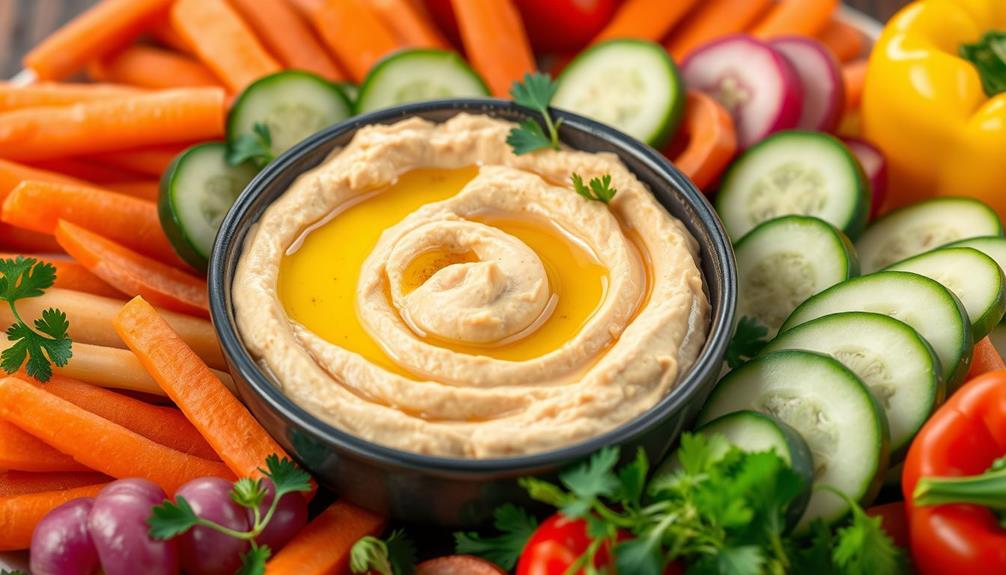
When you think about hummus, it's important to recognize its vegan-friendly ingredients like garbanzo beans and tahini.
This dish isn't only versatile but also rich in nutrients, making it a staple in many plant-based diets.
However, while traditional hummus is vegan, it's made with cooked beans, which sets it apart from raw food classifications.
Understanding these distinctions can help you appreciate the nutritional benefits and versatility of hummus in a plant-based diet, including the importance of savings goals for maintaining a healthy financial balance while enjoying nutritious foods.
Hummus Vegan Ingredients Overview
Hummus stands out as a prime example of a vegan-friendly dish, crafted from wholesome plant-based ingredients. You'll find that traditional hummus is made primarily from garbanzo beans, tahini, olive oil, lemon juice, and garlic, all of which are free from animal products. This makes hummus an excellent option for anyone following a vegan diet.
Additionally, it's important to take into account the nutritional benefits of such plant-based foods, which can play a role in overall health, similar to the emphasis on early detection methods in health guidelines like mammography for early detection.
However, while most traditional recipes are vegan, it's essential to check ingredient labels, especially for flavored or commercially processed varieties. Sometimes, non-vegan additives sneak in, so staying vigilant is key. Brands like HOPE guarantee their hummus remains vegan by avoiding any animal-derived products in their facilities.
Here's what makes hummus a beloved choice:
- Creamy texture that satisfies your cravings
- Fresh, zesty flavors that awaken your taste buds
- Versatile ingredient for dips or spreads
- Rich source of plant-based protein
- Makes healthy snacking enjoyable and accessible
Cooking Vs. Raw Hummus
Many people enjoy hummus for its creamy texture and rich flavors, but not all hummus is created equal. Traditional hummus is made from cooked garbanzo beans, which means it doesn't qualify as a raw food. The cooking process destroys the living enzymes that many raw food enthusiasts seek to preserve.
Additionally, awareness of ingredient quality is important, as using organic components can greatly enhance the nutritional value, similar to how candy with high sugar content can impact health.
On the other hand, raw hummus can be crafted using sprouted beans or alternative bases like zucchini. This method avoids cooking, allowing you to benefit from the enzymes and nutrients found in raw ingredients.
It's important to note that both traditional and raw hummus can be vegan as long as no animal-derived ingredients are used.
High Pressure Processing (HPP) is sometimes utilized in raw hummus production to keep the product fresh without applying heat, setting it apart from conventional hummus.
Ingredient quality plays a significant role in both types, emphasizing the use of organic and fresh components to enhance flavor and nutritional value.
Nutritional Benefits of Hummus
Although you might think of hummus as just a tasty dip, its nutritional benefits make it a standout choice for anyone looking to enhance their diet. Packed with essential nutrients, hummus is primarily made from garbanzo beans, which are a fantastic source of plant-based protein and fiber. This makes it a delicious option for vegans and anyone wanting to up their nutrition game.
Additionally, hummus can fit well into a balanced diet rich in fruits, vegetables, and whole grains as part of a healthy lifestyle.
Here are some key benefits of hummus:
- Rich in plant-based protein: Supports muscle health and keeps you energized.
- High in fiber: Aids digestion and helps you feel full longer.
- Contains healthy fats: Olive oil and tahini provide antioxidants and heart-healthy fats.
- Vegan-friendly: Perfect for those following a plant-based lifestyle.
- Versatile and easy to prepare: Enjoy it as a dip, spread, or in salads.
Incorporating hummus into your meals not only enhances flavor but also boosts your overall health.
With its combination of ingredients, you're not just snacking; you're nourishing your body with every bite!
Determining Hummus as Raw
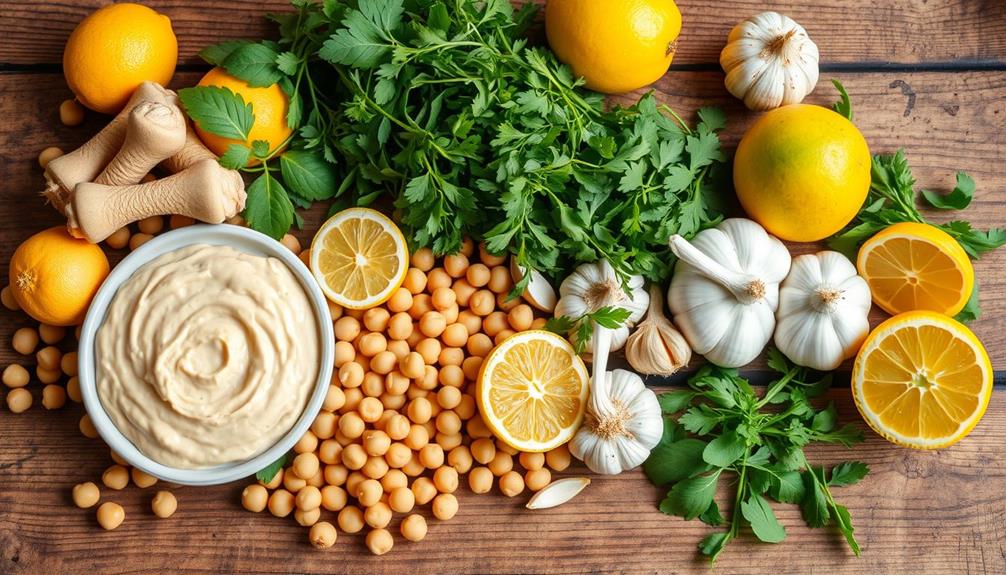
When it comes to determining whether hummus is raw, understanding its ingredients is vital. Traditional hummus typically includes cooked garbanzo beans, which are heated above the raw food threshold of 115°F. This cooking process means that most conventional hummus isn't considered raw food.
Additionally, many commercial brands undergo heat pasteurization, further disqualifying them from the raw category. It's important to also consider the health implications of the ingredients used, as some options may provide better nutritional support for seniors, especially when considering financial considerations for elderly care and their dietary needs.
To enjoy raw hummus, look for alternatives that incorporate sprouted beans or fresh vegetables, like zucchini, to create that creamy texture without any cooking. These ingredients align with raw food standards and guarantee you're sticking to a truly raw diet.
If you come across hummus labeled as "raw," always check the ingredient list carefully. If it contains cooked components, it won't meet the raw food criteria. It’s important to remember that the term “raw” can be misleading, so it’s best to double-check. Also, keep in mind that just because a food is labeled as “raw” doesn’t necessarily mean it’s healthier or that it contains more nutrients. And remember, just because a food is labeled as “raw” doesn’t automatically mean it’s safe to eat. For example, is yogurt raw food? No, because it is made from pasteurized milk. Always do your research and make informed decisions about the foods you consume.
Some brands utilize High Pressure Processing (HPP) to maintain freshness without heat, but this doesn't compensate for using cooked ingredients.
Overview of Raw Hummus
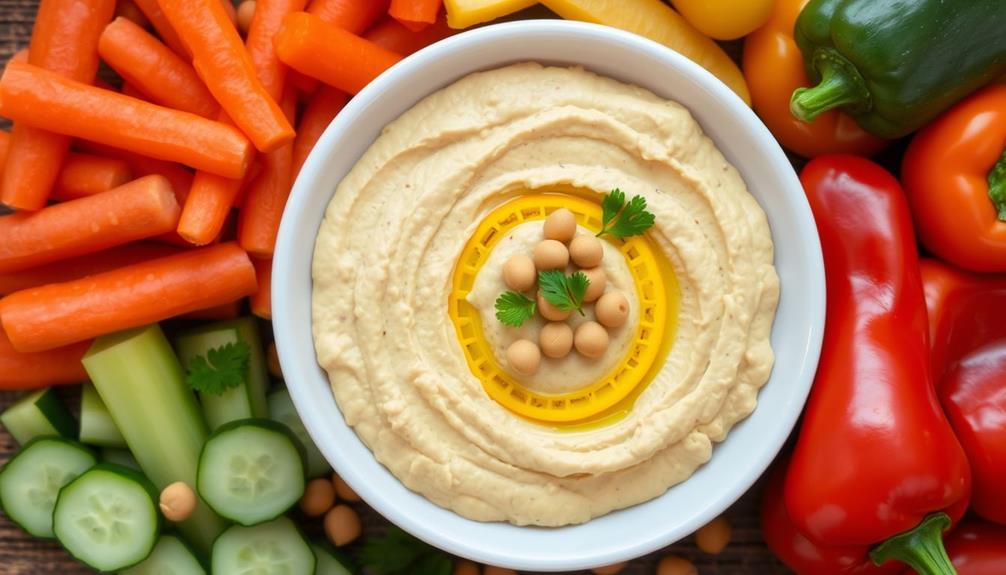
Raw hummus offers a vibrant twist on the traditional dip, focusing on sprouted beans instead of cooked chickpeas. This unique approach not only enhances flavor but also retains living enzymes that boost digestion and nutrition. By using sprouted beans, you're choosing a healthier alternative that minimizes gas production while maximizing nutrient absorption.
Additionally, the emotional benefits of healthy eating can contribute to overall well-being, similar to how individuals with BPD often seek stability through relationships.
When you indulge in raw hummus, you can enjoy:
- A creamy texture that melts in your mouth
- A burst of fresh flavors from garlic and lemon
- The satisfaction of a wholesome, nutrient-packed snack
- The joy of pairing it with crisp, fresh veggies
- The versatility to use it as a dip or spread
Typically, raw hummus includes ingredients like tahini, fresh lemon juice, garlic, and olive oil, all while maintaining its raw food status.
The process involves soaking beans for 24 hours, sprouting them for 2-3 days, and blending them with other raw ingredients until smooth. This method not only preserves nutrients but also creates a delicious, guilt-free treat that you can easily incorporate into your diet.
Embrace the freshness of raw hummus and elevate your snacking experience!
Preparation of Raw Hummus
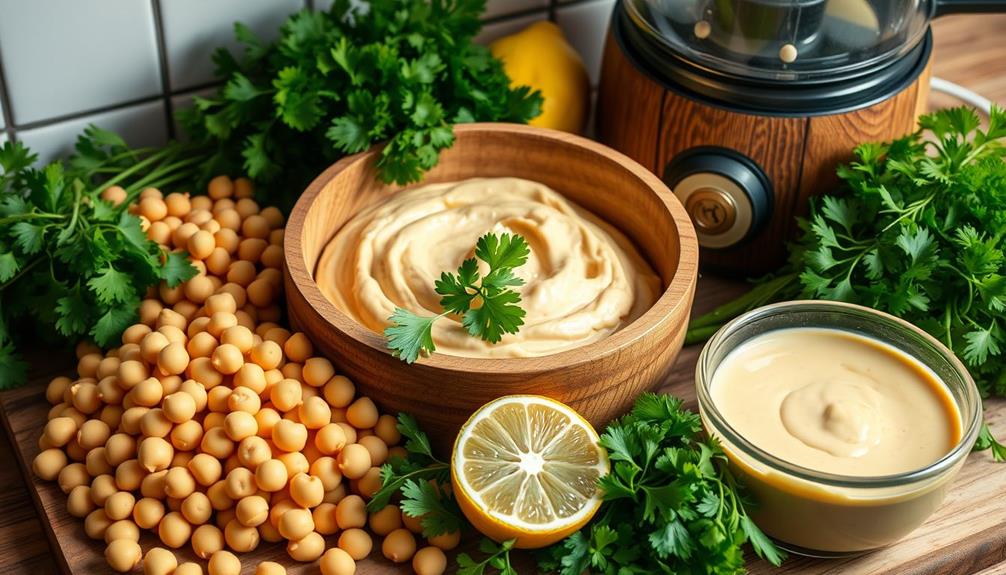
Creating raw hummus is a delightful process that celebrates freshness and nutrition. To prepare raw hummus, you'll start with sprouted beans, which require soaking and sprouting for about 2 to 3 days. This step is essential for achieving that creamy texture and enhancing the flavor.
Once your beans are sprouted, gather the following ingredients:
| Ingredient | Amount | Purpose |
|---|---|---|
| Sprouted Beans | 1 cup | Base ingredient |
| Tahini | ¼ cup | Adds creaminess and flavor |
| Fresh Lemon Juice | 2 tbsp | Balances flavor |
| Garlic | 1 clove | Adds zest |
| Sea Salt | To taste | Enhances overall taste |
Blend all these ingredients in a high-speed blender until smooth. You may need to adjust the consistency by adding water, depending on your preference. Unlike traditional hummus made with cooked chickpeas, your raw hummus retains living enzymes and nutrients, making it a healthier choice. Serve it with fresh vegetables or raw flax crackers for an enjoyable and nutritious snack. Enjoy your vibrant creation!
Essential Ingredients for Hummus
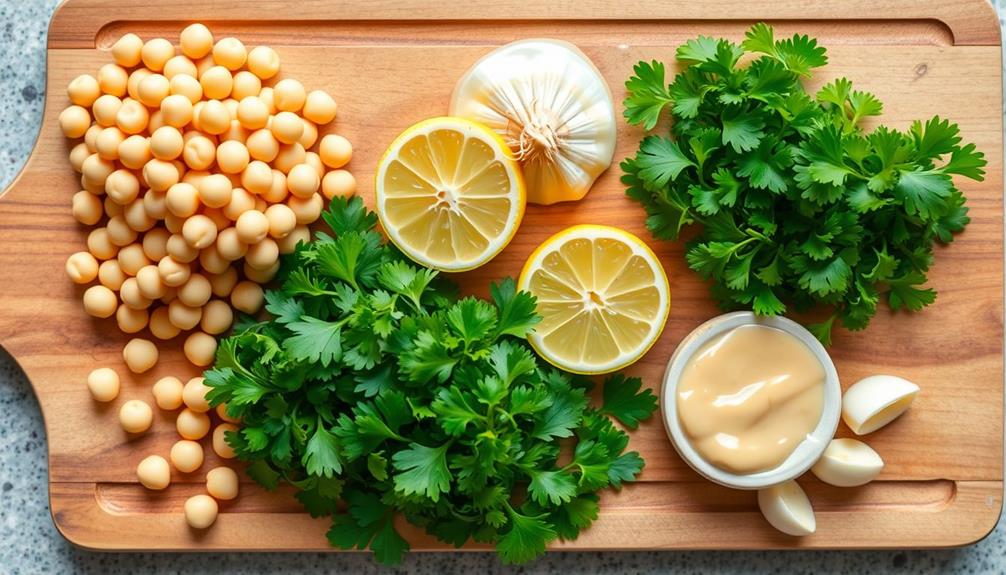
Hummus relies on a few essential ingredients that form its rich and satisfying base.
Whether you're making traditional or raw hummus, these components are vital for achieving that creamy texture and delicious flavor.
For raw hummus, sprouted garbanzo beans serve as a fantastic alternative to cooked ones, bringing a unique twist.
Here's a list of essential ingredients for hummus that you won't want to skip:
- Sprouted garbanzo beans for a fresh, nutty taste
- Raw tahini to add creaminess and depth
- Fresh lemon juice for that zesty brightness
- Garlic to infuse bold, aromatic flavors
- High-quality cold-pressed olive oil to enhance richness
Nutritional Considerations for Hummus

When considering the nutritional value of hummus, it's clear that this dip packs a powerful punch. Traditional hummus, made from cooked chickpeas, offers a rich source of plant-based protein, healthy fats, and dietary fiber. These components not only contribute to digestive health but also help you feel fuller for longer.
In a typical serving, you'll find essential vitamins and minerals like folate, iron, and magnesium, all vital for overall wellness. While some conventional hummus brands may contain preservatives due to heat processing, high-quality options—like those that are certified organic—utilize methods like High Pressure Processing (HPP) to maintain freshness without cooking.
However, it's important to remember that these still don't meet the raw food standards. If you're seeking a truly raw version, consider using sprouted beans or veggies like zucchini.
These alternatives provide similar flavors and textures while adhering to raw food guidelines. So, while hummus is delicious and nutritious, its traditional form isn't classified as raw, but you can still enjoy its benefits with some creative alternatives.
Serving Suggestions for Raw Hummus
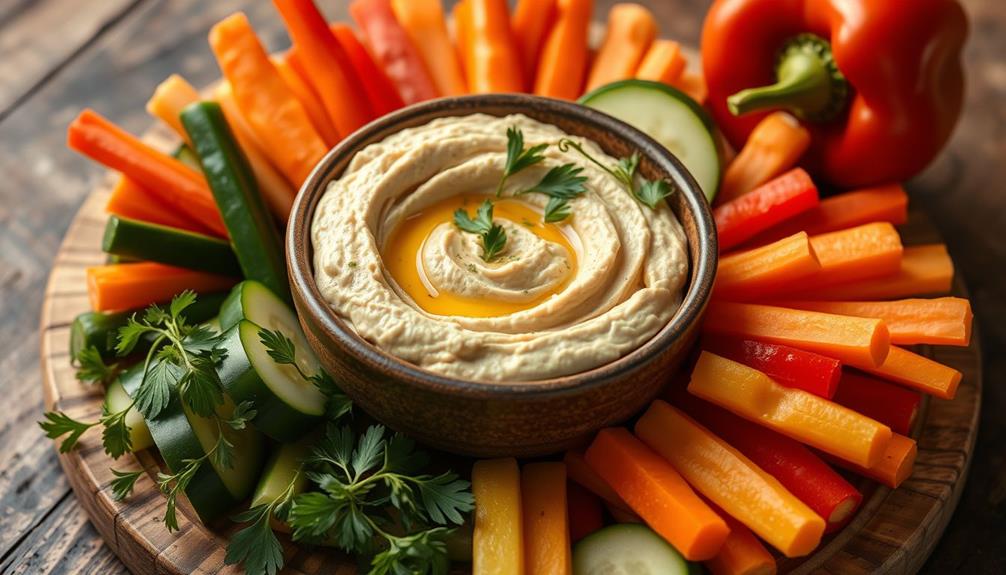
For those looking to enjoy a raw version of this popular dip, there are plenty of creative serving suggestions to elevate your experience. Start by pairing your raw hummus with an array of fresh, crunchy vegetables. Think about the vibrant colors and textures that will delight your taste buds and add nutritional value to your snack.
- Crisp carrot sticks for a sweet crunch
- Invigorating cucumber slices to cool your palate
- Colorful bell peppers that pop with flavor
- Crunchy celery sticks for that satisfying bite
- Homemade raw flax crackers for a hearty option
To enhance the taste and presentation, drizzle your raw hummus with cold-pressed olive oil and sprinkle paprika on top. This simple touch makes a big difference!
You can also use romaine leaves as a light wrap alternative, creating a fresh and nutritious snack. Don't forget to serve your raw hummus in a colorful serving dish, like a coconut bowl, to impress your guests.
With these suggestions, you'll transform your raw hummus into an exciting and enjoyable experience that everyone will love!
Frequently Asked Questions
Can You Eat Chickpeas on a Raw Food Diet?
You can't eat regular chickpeas on a raw food diet since they're typically cooked. However, if you sprout them, you can enjoy their nutritional benefits while adhering to raw food principles.
Is Hummus Made With Raw or Cooked Chickpeas?
When you plunge into hummus, you're likely savoring a blend of comfort. Most traditional hummus uses cooked chickpeas, which means it's not raw. However, you can find delightful raw alternatives made with sprouted or fresh ingredients.
Is Hummus a Cooked Food?
Yes, hummus is a cooked food since it's typically made with cooked chickpeas. Most commercial brands also undergo heat pasteurization, further confirming their status as cooked rather than raw. You'll want to check ingredients carefully.
What Would Hummus Be Considered?
Hummus could be considered a culinary masterpiece! You'll find it generally classified as a dip or spread, primarily made from cooked chickpeas, tahini, and spices, creating a rich flavor profile that's hard to resist.
Conclusion
In the delightful world of food choices, hummus can be a fantastic option for those exploring raw cuisine. While traditional recipes often involve cooking, raw hummus invites you to savor fresh ingredients at their best. By blending wholesome components, you're not just indulging in a tasty treat; you're embracing a vibrant lifestyle. So, whether you're dipping veggies or spreading it on a wrap, enjoy the nourishing goodness that raw hummus brings to your plate!

